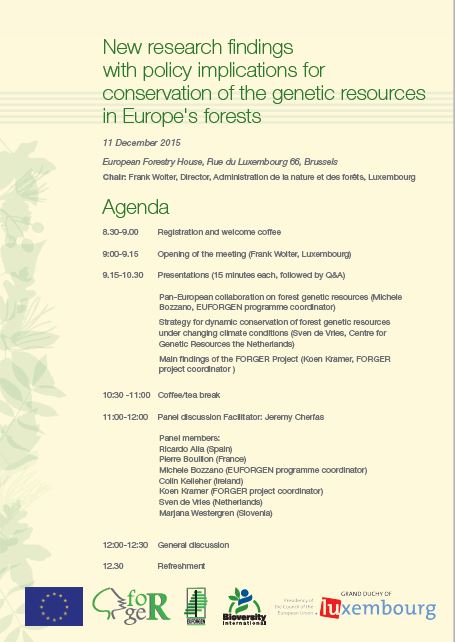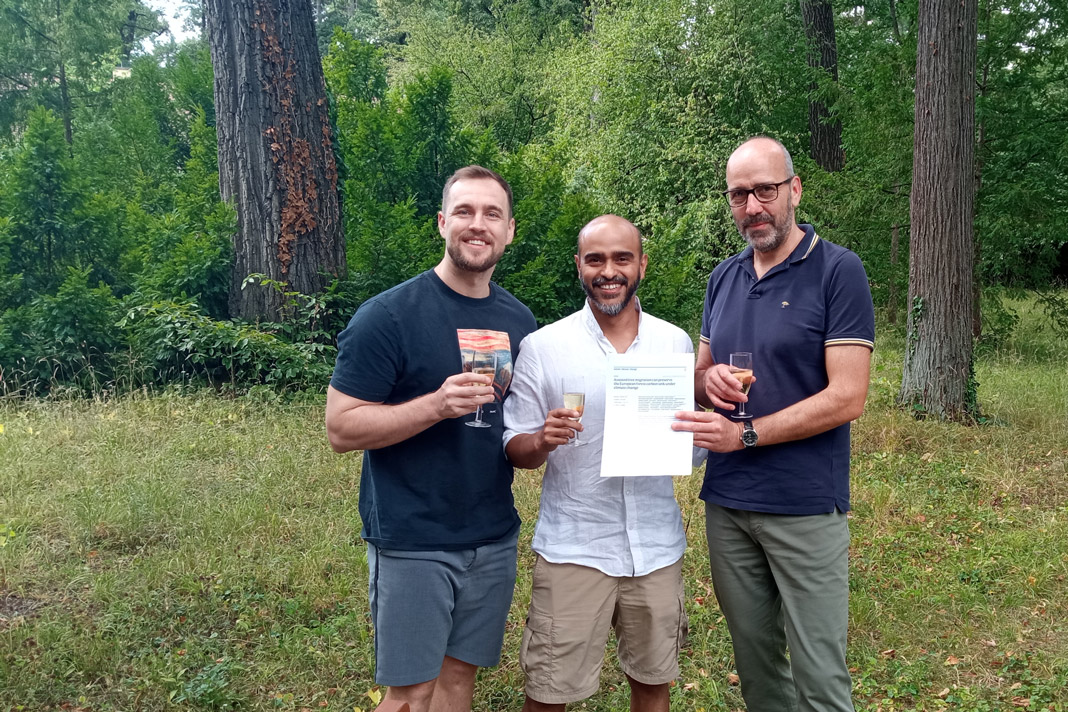Research findings with policy implications for conservation of forest genetic resources in Europe
How can we ensure that the saplings of today will grow into the forests society needs tomorrow? An international meeting held at Forestry House in Brussels on 11 December 2015 gave more than 30 participants, including representatives of five European Commission Directorates General, an opportunity to learn about the latest research on impacts of climate change on forests and to discuss possible implications for EU policy.
As Europe prepares to face the challenges of climate change, the forestry sector poses particular difficulties. Tree seeds germinating now will have to cope with a different climate 50 or 100 years in the future. How can we ensure that the saplings of today will grow into the forests society needs tomorrow? An international meeting held at Forestry House in Brussels on 11 December 2015 gave more than 30 participants, including representatives of five European Commission Directorates General, an opportunity to learn about the latest research on impacts of climate change on forests and to discuss possible implications for EU policy.
Preventing negative impacts of climate change on forests, as recommended by the EU Forest Strategy, requires forests to be able to adapt, which is possible only if sufficient genetic diversity exists within populations of tree species.
Frank Wolter, Director, Administration de la nature et des forêts, Luxembourg, chaired the meeting and reminded participants that for more than 300 years forestry in Europe has been dedicated to ensure that forests supply society’s needs now and into the future. Long-term action is essential, he said, and one of the most important actions is to conserve the diversity of forest genetic resources (FGR).
Michele Bozzano, coordinator of the European Forest Genetic Resources Programme (EUFORGEN), explained that the conservation and sustainable use of FGR are the pillars of EUFORGEN, and the main thrust of the EC-funded project called FORGER. In addition, he pointed out that EUFORGEN plays an important role by providing a platform for all European countries to work together. It enables foresters in all countries to formulate common strategies, to define research priorities for cooperation and to speak with one voice in the effort to shape Regional strategies.
One of the important elements of pan-European cooperation is the establishment of a strategy for the dynamic conservation of FGR, the topic of Sven de Vries’ presentation. De Vries, of the Centre for Genetic Resources in the Netherlands, explained how each country is being encouraged to set up genetic conservation units (GCU) for forest species, with at least one such unit in each of the different ecological zones in which the species is found. This effort will ensure that a minimum of the genetic diversity of the forest species is subject to long-term dynamic conservation. These units will also provide forest reproductive material to restore the adaptive capacity in other forests and will be a source of valuable data to monitor the changes taking place in European forests.
Data from conservation units flow into EUFGIS, the European Information System on Forest Genetic Resources, which is maintained by EUFORGEN. The ability to compare and contrast results from different monitoring sites, including GCUs, across the continent will result in better decisions for national forests, for example by helping to pinpoint planting material that might already be pre-adapted to predicted climatic conditions.
That was the thrust of a presentation by Koen Kramer of the Alterra Research Institute and coordinator of the <link http: www.fp7-forger.eu _blank external-link-new-window external link in new>FORGER project. Kramer pointed out that most forest species in Europe are not on the brink of extinction. However, populations in particular in the south and south-east of Europe, will be under threat. Changing climate will move the most suitable ecological zones across Europe. Some populations at the trailing edge of the species distribution are likely to be best able to cope with reduced water, and so could prove a valuable source of genetic adaptability to water scarcity.
It will take pan-European cooperation in research to identify valuable genetic diversity. Permitting some kinds of forest genetic resources to move across borders may then require changes to European policy. These were just some of the issues explored by participants in the meeting at a panel discussion after the formal presentations.
One of the panellists, Pierre Bouillon, chair of EUFORGEN’s working group on policies relevant to FGR and president of <link http: www.fao.org forestry en _blank external-link-new-window external link in new>FAO’s Intergovernmental Technical Working Group on Forest Genetic Resources, summed up the challenges: adaptation of FGR to climate change, preservation of European forest carbon sinks, integration of FGR management into forest policies. While there is a <link http: www.fao.org a-i3849e.pdf _blank external-link-new-window external link in new>Global Plan of Action for FGR under the Food and Agriculture Organization of the UN, for the conservation, sustainable use and development of forest genetic resources, European countries need to collaborate more to put it into practice. He also underlined that only 19 countries of the Region (14 in the EU) submitted their respective National Reports on the Conservation and Sustainable Use of Forest Genetic Resources as part of the State of the World of Forest Genetic resources report.
Furthermore, countries in Europe cannot decide on their national actions without knowing what their neighbours are doing. That calls for the EU to coordinate and to define regulations, minimum targets and long-term strategies, with technical guidance from EUFORGEN. A broader policy on conservation of forest genetic resources will be needed, making use of the <link http: portal.eufgis.org _blank external-link-new-window external link in new>EUFGIS infrastructure, as trees don’t restrict themselves to political borders. The whole point of conservation is to ensure that the changing needs of society can be met (now and in the future), which means that other stakeholders, such as forest-based industries and environmental concerns, need to be part of the discussion.
Europe’s future forests require no less.








